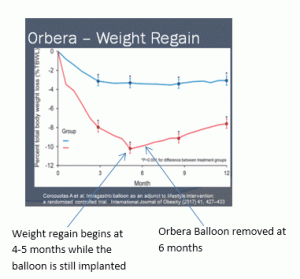Physician’s Area
- Adjustment to prevent early extraction for intolerance
- Adjustment to achieve renewed balloon effect after the 4th month
- Adjustments in combination with 1 year implantation
- Medically significant weight loss maintenance two years after balloon removal
- Prevents early extractions for intolerance
- 18.8% of Orbera balloons extracted early in FDA trials [1]
- Approximately 10-12% of Spatz3 patients undergo down adjustments for intolerance[2,3,4,9]
- Prevents weight regain at months 4-5 after balloon implantation
- publications document that balloons lose their effect at 3-5 months [5,6,7]
- Published results report response rates (>10%TBL or >25%EWL)
- Orbera balloon response rates 46.4% and 45.6%, respectively [1,7]
- Reshape Balloon 48% response rate [8]
- Obalon response rates 24.7% [13]
- Spatz3 Adjustable balloon 71.5% – 88.5% response rate [9,10,11,12]
- That means that with a non-adjustable balloon less than half the patients have a good response. With an adjustable balloon, >80% have a good response.
2 reasons
- Down adjustments save patients from early extractions
- 8% of Orbera patients had early extractions in FDA trials [1]
- 14% of Reshape patients had early extractions in FDA trials [8]
- Approximately 10-12% of Spatz3 patients undergo down adjustments for intolerance[2,3,4,9]
- 87%-91% of Spatz3 intolerant patients that underwent down adjustment were saved from early extraction [2,3,4,9]
- Up adjustments save patients from weight regain after 4-5 months
Additional weight loss of 8.2kg, 8.9kg, 5kg, and 5.7 kg were achieved after the up adjustment in 4 different studies [2,3,4,9]
Mean 300 ml addition yields better results than mean 227 ml [9]
- Probably not
- It has been well documented that on average balloon effect diminishes after 4 months [5,6,7]
- In fact Orbera studies document weight gain at 4-5 month [7]
- While the balloon is still implanted
- Keeping the ineffective balloon in for a longer period of time is not likely to help. But studies need to be done.

Courcoulas published results of 255 patients in a randomized controlled study (modified intention to treat). The patients achieved 10% TBL (loss of 10% of initial weight). Notice that the weight regain begins at 4-5 months – that is 1-2 months prior to Orbera balloon removal. This means that balloon effect diminishes and weight regain begins already at 4-5 months. This is most likely true of all balloons.
A published study of the Orbera balloon reviewed over 600 balloons that remained implanted beyond six months and up to 14 months. The publication concluded as follows:“Conclusion: Extending the duration of BIB(Orbera)) use up to 14 months safely maintains weight loss…” However, significant extra weight loss beyond six months was not achieved[14]. This proves the point that extending implantation beyond six months does not achieve extra weight loss. With the Spatz adjustable balloon, the extended implantation time, in combination with adjustment, has been shown to increase weight loss and responder rates.
It’s very simple and only takes 3 seconds. Watch the short video below
- FDA SSED Orbera Balloon. PMA P140008: FDA Summary of Safety and Effectiveness Data. August 5, 2015.
- Machytka E, Brooks J, Buzga M and Mason J (2014) One year adjustable intragastric balloon: safety and efficacy of the Spatz3 adjustable balloons [v1; http://f1000r.es/471] F1000Research 2014, 3:203
- Machytka E, Marinos G2, Kerdahi R, Srivastava ED, AlLehibi A ,Mason J, Brooks J. Spatz Adjustable Balloons: Results of Adjustment for Intolerance and for Weight Loss Plateau. DDW 2015, IFSO 2015
- Brooks J, Tsvang E, Ganon M, Arnon R. Spatz3 Adjustable Balloon: Early adjustment to prevent premature extraction. DDW 2016
- Bonazzi P, Petrelli MD, Lorenzini I, et al. Gastric emptying and intragastric balloon in obese patients. Eur Rev Med Pharmacol Sci. 2005; 9(5 Suppl 1):15–21.
- Totte E, Hendricks L, Pauwels M, et al. Wt reduction by means of an intragastric device; experience with BIB. Obes Surg. 2001; 11(4):519–23.
- Courcoulas A et al. Intragastric balloon as an adjunct to lifestyle intervention: A randomized controlled trial. International Journal of Obesity (2017) 41, 427–433
- FDA SSED Reshape Duo Balloon. PMA P140012: FDA Summary of Safety and Effectiveness Data. July 28, 2015
- Machytka, Evzen; Puig Divi, Valenti; Saenger, Fernando; Sorio, Ricardo; Brooks, Jeffrey. Adjustable Balloons for Weight Loss: A Higher Yield of Responders Compared with Non-Adjustable Balloons. DDW 2017 Abstract.
- Usuy Eduardo, Brooks Jeffrey. Response Rates with the Spatz3 Adjustable Balloon. Obes Surg. 2017 Oct 31. doi: 10.1007/s11695-017-2994-x. [Epub ahead of print]
- Almeida Leonardo S. Spatz3 Adjustable Balloon; Weight Loss And Response Rates In Brazil. Int Gast Hepatol, 1(1): 38-41 (2018)
- Brooks J. Adjustable Intragastric Balloons Improve Response Rates. DDW 2018 Abstract.
- FDA SSED Obalon Balloon. PMA P160001: FDA Summary of Safety and Effectiveness Data. September 8, 2016
- Genco A, et al. Intragastric balloon for obesity treatment: results of a multicentric evaluation for balloons left in place for more than 6 months. Surg Endoscopy. 2015 Aug;29(8):2339-43. doi: 10.1007/s00464-014-3957-0. Epub 2014 Dec 6.
Contact a Spatz3 representative
near you

